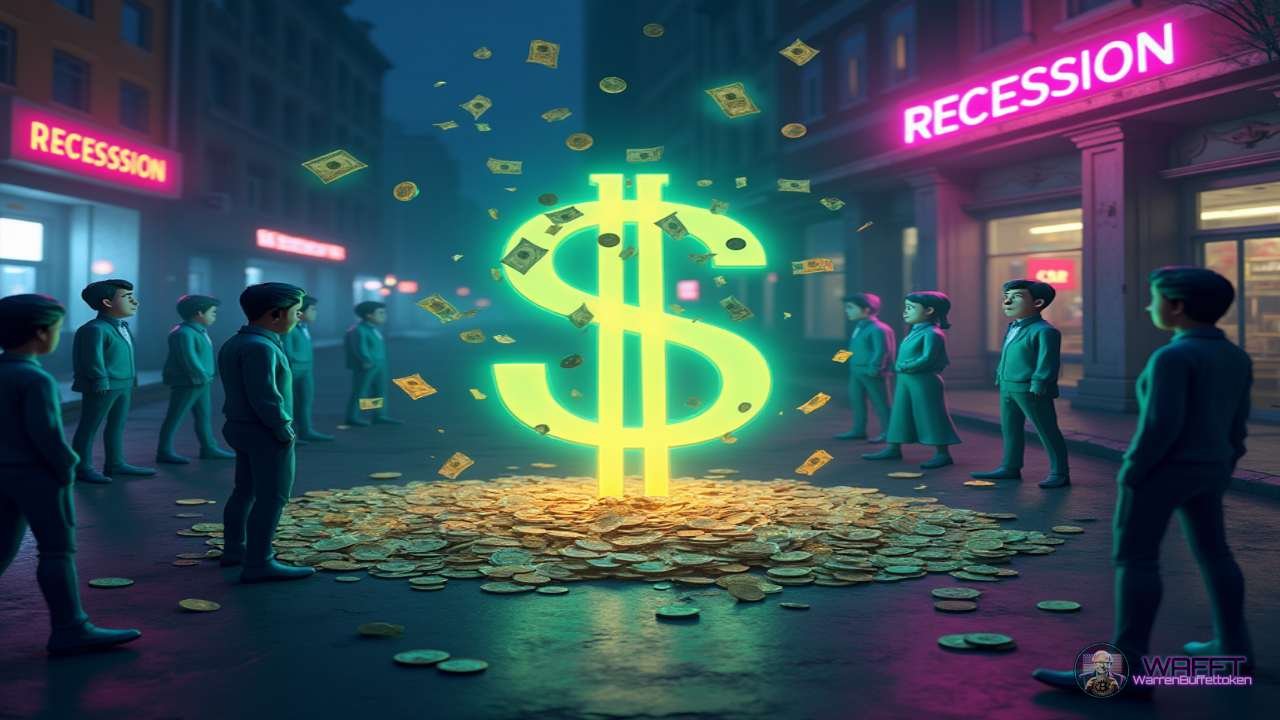Monetary Contraction:
Welcome to the fascinating world of monetary tightening! Although it sounds a bit technical, understanding this concept is key to knowing how central banks and governments manage the economy. Monetary tightening is a phenomenon that affects the flow of money in the economy and therefore influences our daily lives, from what we pay for bread to the interest rates on our mortgages. 🌐💸
Let’s break it down in a simple way so you can understand what it is, how it works, and why it matters so much in the global economy. 🚀

What is monetary contraction? 🤔
In simple terms, monetary contraction is a reduction in the supply of money available in the economy. This means that there is less money circulating between people, businesses, and banks. Monetary contraction usually occurs when central banks (such as the Federal Reserve in the US or the European Central Bank) decide to reduce the amount of money in the economy to curb inflation or prevent economic overheating.
How do they do it?
Central banks can achieve monetary contraction through several tools, but the most common ones are:
Raising interest rates 📈:
When the central bank raises interest rates, borrowing money becomes more expensive. This discourages people and businesses from borrowing, reducing spending and investment, which decreases the amount of money in circulation.
Selling government bonds 🏛️:
Another tool is the sale of bonds by the central bank. By selling bonds, the bank takes money out of circulation because bond buyers hand over cash in exchange for these financial assets.
Increase bank reserve requirements 🏦:
Commercial banks must hold a percentage of their deposits as reserves at the central bank. If the central bank increases that requirement, banks will have less money available to lend.
Why is monetary tightening implemented? 🎯
Monetary tightening is not something central banks do on a whim. It is usually implemented when the economy is overheating, which can lead to high inflation.
🔥 What is inflation and why is it bad?
Inflation is the general increase in the prices of goods and services. A little inflation is normal and healthy for the economy, but when inflation spikes, the value of money falls. That is, your money loses purchasing power, and what you used to buy with $10 now costs you $12, $15, or more. 📈💸
Monetary tightening slows inflation by reducing the amount of money in circulation, which decreases demand in the economy. Less demand means that prices for goods and services stop rising as quickly.
History of Monetary Contraction: Famous Cases 💸📉
Monetary contraction occurs when the amount of money in circulation is reduced, leading to falls in demand, deflation, and an economic slowdown. Throughout history, several economic crises have been deepened by this phenomenon.
Here are some of the most famous cases:
1. The Great Depression (1929-1939) 🏦💥
The stock market crash in 1929 in the US was a trigger for one of the worst economic crises in history: The Great Depression. After the crash, banks began to fail because loans were not being repaid. Instead of expanding the money supply, the Federal Reserve allowed the money in circulation to decrease by 30% 📉. This caused deflation, a drastic fall in prices and a reduction in consumer and business spending. The unemployment rate in the US reached almost 25% 😰, and the effects were felt all over the world 🌍.
2. The Volcker Experiment (1980) 💣💵
One of the most famous examples of monetary contraction is the US Federal Reserve’s policy during the 1980s under Paul Volcker. At the time, the US was dealing with runaway inflation hovering around 14%. A nightmare for consumers and the economy! 💥
In 1979, Paul Volcker, then chairman of the US Federal Reserve, implemented one of the most aggressive monetary contractions in history to combat runaway inflation 🔥. During the 1970s, the US had experienced high inflation due to the oil crisis and uncontrolled government spending. To break the inflationary cycle, Volcker raised interest rates 📈 to unprecedented levels, reaching 20% in 1981 😱. This drastically reduced the money supply 💸 and while it managed to control inflation, it also caused a deep recession in the US 🇺🇸.
The unemployment rate soared to 10.8% in 1982, and the economic contraction was especially hard on the construction and manufacturing sectors 🏗️.
Despite the short-term economic pain, Volcker’s monetary contraction stabilized prices and laid the groundwork for decades of sustained growth🔝💲.

3. Latin American crisis (1980s) 💣💵
During the 1980s, several Latin American countries, such as Mexico 🇲🇽, Argentina 🇦🇷, and Brazil 🇧🇷, experienced a severe debt crisis. These countries had borrowed massively in the 1970s, but rising global interest rates (mainly in the US) and falling export prices meant they were unable to pay their debts 💵.
Under pressure from the International Monetary Fund (IMF), they implemented austerity policies that reduced the money supply 💸. This led to a massive economic contraction, with prolonged recessions, sky-high inflation 💥, and the collapse of several national currencies 📉.
4. Japan and the “Lost Decade” (1990s) 🏯❄️
In the 1980s, Japan experienced an economic boom fueled by a real estate and stock market bubble 📊. However, when the bubble burst in the early 1990s, the Bank of Japan decided to raise interest rates 📈 to contain inflation, leading to a sharp monetary contraction. Prices began to fall 📉 (deflation), businesses and consumers stopped spending, and economic growth stagnated for more than a decade. This persistent deflation and economic stagnation are known as Japan’s “Lost Decade” 📆.
5. Global Financial Crisis (2008) 💼🌍
The 2008 financial crisis was triggered by the collapse of the US subprime mortgage market 🏠💥.
The contraction in global credit was massive: banks stopped lending money to each other, causing the financial system to freeze 🧊. As businesses and consumers lost access to credit, the global economy went into a tailspin 📉.
The initial contraction in the flow of money led to a global recession, although central banks like the Federal Reserve quickly responded with expansionary monetary policies to stabilize the system 💸.
6. Euro crisis (2010-2012) 💶⚠️
Following the 2008 financial crisis, several eurozone countries, such as Greece 🇬🇷, Spain 🇪🇸 and Italy 🇮🇹, faced a sharp economic contraction caused by austerity policies imposed by the European Union and the European Central Bank.
These highly indebted countries had to drastically reduce public spending and available credit 💸 to comply with the strict fiscal measures imposed by their creditors. As a result, the economies of these countries contracted severely 📉, unemployment reached record levels, and confidence in the eurozone was shaken 😬.
Conclusion 🏁
History shows that monetary contractions can have devastating effects on the economy if not managed carefully. From the Great Depression to contemporary crises such as the Latin American crisis or the Volcker experiment, reducing the money supply has been a tool to combat inflation, but often at a high social and economic cost 💸⚖️.
Proper management of monetary policy is key to preventing a recession from turning into a prolonged crisis.

What effects does monetary contraction have? ⚖️
The effects of monetary contraction can be mixed. In theory, it reduces inflation, but it can also have some important side effects:
Economic recession:
If money becomes too scarce, spending and investment are reduced, which can slow the economy and lead to a recession. 🛑📉
Rising unemployment:
Businesses, having less access to cheap credit, may reduce their production and lay off employees, which increases unemployment. 🏭
Higher cost of borrowing:
With higher interest rates, consumers and businesses find it more expensive to borrow, affecting everything from mortgages to financing new projects. 💰📊
Strengthening of the currency:
Less money in circulation and higher interest rates often cause one currency to strengthen against others, which can benefit importers but hurt exporters. 🌍💱
When is monetary tightening necessary? 🔍
Monetary tightening is applied when central banks believe that inflation is out of control or that economic growth is unsustainable. The idea is to cool the economy a bit, reducing demand to avoid a bigger crisis in the future.
But it is a delicate balance: if the central bank applies too much contraction, it can hurt the economy; if it applies too little, inflation can continue to run wild.
The future of monetary tightening: an evolving tool? 🔮
Today, central banks have a wealth of tools at their disposal to manage the money supply, from interest rate policies to asset purchase programs. However, the use of monetary tightening remains one of the most powerful tools to maintain economic stability.
In a world where inflation can be driven by global factors (such as supply shocks or trade wars), monetary tightening policies will need to adapt to new challenges. Furthermore, with the growth of cryptocurrencies and central bank digital currencies (CBDCs), we could see an evolution in how banks manage the flow of money in the future. 💻🔗
Conclusion 📜
Monetary tightening is one of those economic tools that central banks use to control inflation and maintain balance in the economy. Although it can have side effects such as recession or unemployment, it is also key to avoiding long-term economic crises.
The next time you hear that central banks are raising interest rates or selling bonds, you will already know that they are applying a monetary tightening policy to protect the economy from the risks of excess money in circulation. 💡


